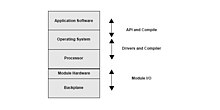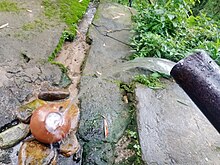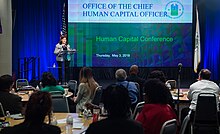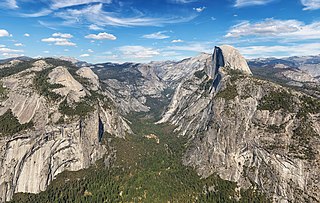Computer resources

A computer resource is any physical or virtual component of limited availability within a computer or information management system. Computer resources include means for input, processing, output, communication, and storage. [3]
Resource refers to all the materials available in our environment which are technologically accessible, economically feasible and culturally sustainable and help us to satisfy our needs and wants. Resources can broadly be classified according to their availability as renewable or national and international resources. An item may become a resource with technology. The benefits of resource utilization may include increased wealth, proper functioning of a system, or enhanced well. From a human perspective, a regular resource is anything to satisfy human needs and wants. [1] [2]
The concept of resources has been developed across many established areas of work, in computer science, management, and human resources for example - linked to the concepts of competition, sustainability, conservation, and stewardship. In application within human society, commercial or non-commercial factors require management]].
The concept of resources can also be tied to the direction of leadership over resources; this may include human resources issues, for which leaders are responsible, in managing, supporting, or directing those matters and the resulting necessary actions. For example, in the cases of professional groups, innovative leaders and technical experts in archiving expertise, academic management, association management, business management, management, administration management, public administration, spiritual leadership and social administration.
Resource competition can vary from completely symmetric (all individuals receive the same amount of resources, irrespective of their size, known also as scramble competition) to perfectly size symmetric (all individuals exploit the same amount of resource per unit biomass) to absolutely size asymmetric (the largest individuals exploit all the available resource).
There are three fundamental differences between economic versus ecological views: 1) the economic resource definition is human-centered (anthropocentric) and the biological or ecological resource definition is nature-centered (biocentric or ecocentric); 2) the economic view includes desire along with necessity, whereas the biological view is about basic biological needs; and 3) economic systems are based on markets of currency exchanged for goods and services, whereas biological systems are based on natural processes of growth, maintenance, and reproduction. [1]

A computer resource is any physical or virtual component of limited availability within a computer or information management system. Computer resources include means for input, processing, output, communication, and storage. [3]

Natural resources are derived from the environment. Many natural resources are essential for human survival, while others are used to satisfy human desire. Conservation is the management of natural resources with the goal of sustainability. Natural resources may be further classified in different ways. [1]
Resources can be categorized based on origin:
Natural resources are also categorized based on the stage of development:

Natural resources can be categorized based on renewability:
Depending upon the speed and quantity of consumption, overconsumption can lead to depletion or the total and everlasting destruction of a resource. Important examples are agricultural areas, fish and other animals, forests, healthy water and soil, cultivated and natural landscapes. Such conditionally renewable resources are sometimes classified as a third kind of resource or as a subtype of renewable resources. Conditionally renewable resources are presently subject to excess human consumption and the only sustainable long-term use of such resources is within the so-called zero ecological footprint, where humans use less than the Earth's ecological capacity to regenerate.
Natural resources are also categorized based on distribution:
Actual vs. potential natural resources are distinguished as follows:
Based on ownership, resources can be classified as individual, community, national, and international.

In economics, labor or human resources refers to the human effort in the production of goods and rendering of services. Human resources can be defined in terms of skills, energy, talent, abilities, or knowledge. [4]
In a project management context, human resources are those employees responsible for undertaking the activities defined in the project plan. [5]
In economics, capital goods or capital are "those durable produced goods that are in turn used as productive inputs for further production" of goods and services. [6] A typical example is the machinery used in a factory. At the macroeconomic level, "the nation's capital stock includes buildings, equipment, software, and inventories during a given year." [7] Capitals are the most important economic resource.
Whereas, tangible resources such as equipment have an actual physical existence, intangible resources such as corporate images, brands and patents, and other intellectual properties exist in abstraction. [8]
Typically resources cannot be consumed in their original form, but rather through resource development they must be processed into more usable commodities and usable things. The demand for resources is increasing as economies develop. There are marked differences in resource distribution and associated economic inequality between regions or countries, with developed countries using more natural resources than developing countries. Sustainable development is a pattern of resource use, that aims to meet human needs while preserving the environment. [1] Sustainable development means that we should exploit our resources carefully to meet our present requirement without compromising the ability of future generations to meet their own needs. The practice of the three R's – reduce, reuse, and recycle must be followed to save and extend the availability of resources.
Various problems are related to the usage of resources:
Various benefits can result from the wise usage of resources:

Natural resources are resources that are drawn from nature and used with few modifications. This includes the sources of valued characteristics such as commercial and industrial use, aesthetic value, scientific interest, and cultural value. On Earth, it includes sunlight, atmosphere, water, land, all minerals along with all vegetation, and wildlife.

Environmental economics is a sub-field of economics concerned with environmental issues. It has become a widely studied subject due to growing environmental concerns in the twenty-first century. Environmental economics "undertakes theoretical or empirical studies of the economic effects of national or local environmental policies around the world. ... Particular issues include the costs and benefits of alternative environmental policies to deal with air pollution, water quality, toxic substances, solid waste, and global warming."

Resource depletion is the consumption of a resource faster than it can be replenished. Natural resources are commonly divided between renewable resources and non-renewable resources. The use of either of these forms of resources beyond their rate of replacement is considered to be resource depletion. The value of a resource is a direct result of its availability in nature and the cost of extracting the resource. The more a resource is depleted the more the value of the resource increases. There are several types of resource depletion, including but not limited to: mining for fossil fuels and minerals, deforestation, pollution or contamination of resources, wetland and ecosystem degradation, soil erosion, overconsumption, aquifer depletion, and the excessive or unnecessary use of resources. Resource depletion is most commonly used in reference to farming, fishing, mining, water usage, and the consumption of fossil fuels. Depletion of wildlife populations is called defaunation.

Uneconomic growth is economic growth that reflects or creates a decline in the quality of life. The concept is used in human development theory, welfare theory, and ecological economics. It is usually attributed to ecological economist Herman Daly, though other theorists may also be credited for the incipient idea, According to Daly, "uneconomic growth occurs when increases in production come at an expense in resources and well-being that is worth more than the items made." The cost, or decline in well-being, associated with extended economic growth is argued to arise as a result of "the social and environmental sacrifices made necessary by that growing encroachment on the eco-system."
In economics, capital goods or capital are "those durable produced goods that are in turn used as productive inputs for further production" of goods and services. A typical example is the machinery used in a factory. At the macroeconomic level, "the nation's capital stock includes buildings, equipment, software, and inventories during a given year."
Overconsumption describes a situation where a consumer overuses their available goods and services to where they can't, or don't want to, replenish or reuse them. In microeconomics, this may be described as the point where the marginal cost of a consumer is greater than their marginal utility. The term overconsumption is quite controversial in use and does not necessarily have a single unifying definition. When used to refer to natural resources to the point where the environment is negatively affected, it is synonymous with the term overexploitation. However, when used in the broader economic sense, overconsumption can refer to all types of goods and services, including manmade ones, e.g. "the overconsumption of alcohol can lead to alcohol poisoning". Overconsumption is driven by several factors of the current global economy, including forces like consumerism, planned obsolescence, economic materialism, and other unsustainable business models and can be contrasted with sustainable consumption.

A non-renewable resource is a natural resource that cannot be readily replaced by natural means at a pace quick enough to keep up with consumption. An example is carbon-based fossil fuels. The original organic matter, with the aid of heat and pressure, becomes a fuel such as oil or gas. Earth minerals and metal ores, fossil fuels and groundwater in certain aquifers are all considered non-renewable resources, though individual elements are always conserved.

The exploitation of natural resources describes using natural resources, often non-renewable or limited, for economic growth or development. Environmental degradation, human insecurity, and social conflict frequently accompany natural resource exploitation. The impacts of the depletion of natural resources include the decline of economic growth in local areas; however, the abundance of natural resources does not always correlate with a country's material prosperity. Many resource-rich countries, especially in the Global South, face distributional conflicts, where local bureaucracies mismanage or disagree on how resources should be utilized. Foreign industries also contribute to resource exploitation, where raw materials are outsourced from developing countries, with the local communities receiving little profit from the exchange. This is often accompanied by negative effects of economic growth around the affected areas such as inequality and pollution

An economic system, or economic order, is a system of production, resource allocation and distribution of goods and services within a society. It includes the combination of the various institutions, agencies, entities, decision-making processes, and patterns of consumption that comprise the economic structure of a given community.

Environmental resource management or environmental management is the management of the interaction and impact of human societies on the environment. It is not, as the phrase might suggest, the management of the environment itself. Environmental resources management aims to ensure that ecosystem services are protected and maintained for future human generations, and also maintain ecosystem integrity through considering ethical, economic, and scientific (ecological) variables. Environmental resource management tries to identify factors between meeting needs and protecting resources. It is thus linked to environmental protection, resource management, sustainability, integrated landscape management, natural resource management, fisheries management, forest management, wildlife management, environmental management systems, and others.

The energy industry is the totality of all of the industries involved in the production and sale of energy, including fuel extraction, manufacturing, refining and distribution. Modern society consumes large amounts of fuel, and the energy industry is a crucial part of the infrastructure and maintenance of society in almost all countries.

William Dawbney Nordhaus is an American economist. He was a Sterling Professor of Economics at Yale University, best known for his work in economic modeling and climate change, and a co-recipient of the 2018 Nobel Memorial Prize in Economic Sciences. Nordhaus received the prize "for integrating climate change into long-run macroeconomic analysis".

Environmental goods are typically non-market goods, including clean air, clean water, landscape, green transport infrastructure, public parks, urban parks, rivers, mountains, forests, and beaches. Environmental goods are a sub-category of public goods. Concerns with environmental goods focus on the effects that the exploitation of ecological systems have on the economy, the well-being of humans and other species, and on the environment. Users not having to pay an upfront cost and external factors like pollution that can damage environmental goods indefinitely are some of the challenges in protecting environmental goods.

Common goods are defined in economics as goods that are rivalrous and non-excludable. Thus, they constitute one of the four main types based on the criteria:

In economics, scarcity "refers to the basic fact of life that there exists only a finite amount of human and nonhuman resources which the best technical knowledge is capable of using to produce only limited maximum amounts of each economic good." If the conditions of scarcity didn't exist and an "infinite amount of every good could be produced or human wants fully satisfied ... there would be no economic goods, i.e. goods that are relatively scarce..." Scarcity is the limited availability of a commodity, which may be in demand in the market or by the commons. Scarcity also includes an individual's lack of resources to buy commodities. The opposite of scarcity is abundance. Scarcity plays a key role in economic theory, and it is essential for a "proper definition of economics itself".
"The best example is perhaps Walras' definition of social wealth, i.e., economic goods. 'By social wealth', says Walras, 'I mean all things, material or immaterial, that are scarce, that is to say, on the one hand, useful to us and, on the other hand, only available to us in limited quantity'."

Natural resource economics deals with the supply, demand, and allocation of the Earth's natural resources. One main objective of natural resource economics is to better understand the role of natural resources in the economy in order to develop more sustainable methods of managing those resources to ensure their availability for future generations. Resource economists study interactions between economic and natural systems, with the goal of developing a sustainable and efficient economy.

Earth Overshoot Day (EOD) is the calculated illustrative calendar date on which humanity's resource consumption for the year exceeds Earth’s capacity to regenerate those resources that year. The term "overshoot" represents the level by which human population's demand overshoots the sustainable amount of biological resources regenerated on Earth. When viewed through an economic perspective, the annual EOD represents the day by which the planet's annual regenerative budget is spent, and humanity enters environmental deficit spending. EOD is calculated by dividing the world biocapacity, by the world ecological footprint, and multiplying by 365, the number of days in a year:
The biocapacity or biological capacity of an ecosystem is an estimate of its production of certain biological materials such as natural resources, and its absorption and filtering of other materials such as carbon dioxide from the atmosphere.
Resource consumption is about the consumption of non-renewable, or less often, renewable resources. Specifically, it may refer to:
Eco-restructuring is the implication for an ecologically sustainable economy. The principle of ecological modernization establishes the core literature of the functions that eco-restructuring has within a global regime. Eco-restructuring has an emphasis on the technological progressions within an ecological system. Government officials implement environmental policies to establish the industrial- ecological progressions that enable the motion of economic modernization. When establishing economic growth, policy makers focus on the progression towards a sustainable environment by establishing a framework of ecological engineering. Government funding is necessary when investing in efficient technologies to stimulate technological development.